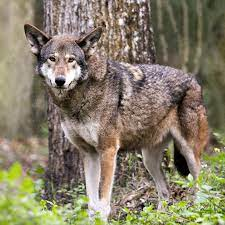It is possible that in the last week you’ve seen a few stories on the news about red wolves. Many people have seen these stories but few actually know the whole story. In 2022, several conservation groups–including the Red Wolf Institute and the Animal Welfare Institute–filed a lawsuit claiming that the US Fish and Wildlife Service (USFWS) violated the Endangered Species Act. These claims arose after the USFWS neglected to manage and reintroduce the species when it earned a spot on the endangered species list. Both sides of the lawsuit recently came to a conclusion, resulting in a new plan to reintroduce red wolves to the Albemarle Peninsula of North Carolina, the only place in the world with a wild population left.
Dwindling numbers became a problem in the 1700s and 1800s due to the North American fur trade. Like many furbearers, red wolves were hunted and trapped for their prized pelts, which are bigger, thicker, and more colorful (and therefore more desired). Although the fur trade somewhat subsided in the 1900s, red wolves continued to be hunted because they posed a threat to livestock and game species. Finally, in 1966, the species was moved from “threatened with endangerment” to “endangered.” As of today, with just an estimated 25 left, the red wolf has been designated “a critically endangered species” under the Endangered Species Act and is therefore federally protected.
If that’s the case, then why don’t we still have a healthy population? In 1987, the NC Fish and Wildlife Service began to reintroduce red wolves into the eastern part of the state but failed after conflicts with landowners (who often shot red wolves after mistaking them for coyotes) and the hybridization with local coyote populations, which decreased the number of pure wolves. After the failed reintroduction, NCFWS gave up on the species and halted all reintroduction efforts. Through the years, different private conservation efforts have been made, culminating in the recent lawsuit.
Other than the potential loss of this vital keystone species, why should we care about the red wolf’s potential extinction? The red wolf is a keystone species to the state with connections to many other species of flora and fauna. According to the Association of Zoos and Aquariums, without the red wolf, many of NC’s ecosystems would begin to collapse.
With the new ruling made, many people question what will come in the future. The new ruling forces the USFWS to publish an 8-year reintroduction plan that also reinstates coyote sterilization to prevent hybridization. Additionally, a new agreement is circulating that allows landowners to sign up to let the wolves live on their property without interference.
If you are interested in helping save this important species, simply learning more about red wolves is a great place to start. You can also check out live footage of a red wolf den or visit the Red Wolf Center on the Pocosin Lakes National Wildlife Refuge in Columbia, NC. Finally, consider signing the agreement or donating to conservation groups involved with the reintroduction.













